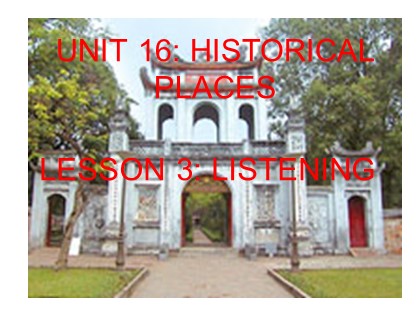Bài giảng Tiếng Anh Lớp 10 - Unit 16: Historical places - Lesson 3: Listening
Vocabulary
Merchant (n) = businessman
Pillar (n) cột chống làm bằng đá,gỗ hay kim loại
Vessel (n)
ornamental (adj.) để trang trí
Assembly Hall of Cantonese Chinese Congregation: Hội Quán Quảng Đông
Bạn đang xem tài liệu "Bài giảng Tiếng Anh Lớp 10 - Unit 16: Historical places - Lesson 3: Listening", để tải tài liệu gốc về máy hãy click vào nút Download ở trên
Tóm tắt nội dung tài liệu: Bài giảng Tiếng Anh Lớp 10 - Unit 16: Historical places - Lesson 3: Listening

in the 19 th century C. in the Far East 3 .Hoi An is an well-known for its old houses which are ______ . A. Small and thatch-roofed B. Narrow and carved C. Small and tile-roofed 4 . The Japanese covered Bridge was built ______ . A. in 1855 B. in the 18 th century C. in the 16 th century 5 . Tan Ky House was built as a ______ . A. house for a Chinese merchant B. meeting hall for the Cantonese Chinese C. house for a Vietnamese merchant Task 1: Listen and choose A,B or C that best completes the sentences. Hoi An is located ____ kilometers south of Da Nang . A. 13 B . 30 C . 16 2 . Hoi An used to be an important trading centre ______ . A. in Southeast Asia B. in the 18th century C. in the Far East √ √ 3 . Hoi An is an well-known for its old houses which are ______ . A. Small and thatch-roofed B. Narrow and carved C. Small and tile-roofed 4 . The Japanese covered Bridge was built ______ . A. in 1855 B. in the 18th century C. in the 16th century √ √ 5 . Tan Ky House was built as a ______ . A. house for a Chinese merchant B. meeting hall for the Cantonese Chinese C. house for a Vietnamese merchant √ Task 2: Listen again and answer the following questions. 1 . Where is the ancient town of Hoi An? It lies on the Thu Bon River, 30km south of Da Nang . 2 . What was Hoi An known as between the 16 th and the 17 th century? It was known as a major trading centre in Southeast Asia between the 16th and the 17th centuries. 3 . What is it now famous for? It is now famous for its old temples, pagodas, small tile-roofed houses and narrow streets. 4 . What are the old houses in Hoi An like? They were made of wood and their pillars were carved with ornamental designs. 5 . How old is the Assembly Hall of Cantonese Chinese Congregation? It was built in 1855. / It’s 152 years old. 6 . When was Tan Ky House built? It was built nearly two centuries ago . 7 . What is special about this house? It now looks almost exactly as it did in the early 19th century. 8 . When was Hoi An recognized by UNESCO as a Cultural Heritage Site? In 1999. Talk about the ancient town of Hoi An . * Hoi An’s location and roles in the past: - It lies on the Thu Bon River, 30km south from Da Nang . - It was formerly a major trading centre in Southeast Asia between the 16th and the 17th centuries. - It was also an important port for Dutch, Portuguese, Italian, Chinese, Japanese and other merchant vessels from the Far East. * Hoi An’s attractive characteristics at present: - It is famous for its old temples, pagodas, small tile-roofed houses and narrow streets. - All the houses were made of wood and their pillars were carved with ornamental designs. * Hoi An’s main tourist attractions and their features: - The Japanese Covered Bridge was built in the 16th century and is still well-preserved. - The Assembly Hall of Cantonese Chinese Congregation was built in 1855 and still keeps many precious objects that belonged to the Chinese community of Hoi An. - Tan Ky House was constructed nearly two centuries ago as a house for a Vietnamese merchant. It now looks almost exactly as it did in the early 19th century.
File đính kèm:
 bai_giang_tieng_anh_lop_10_unit_16_historical_places_lesson.ppt
bai_giang_tieng_anh_lop_10_unit_16_historical_places_lesson.ppt

